President Donald Trump has intensified his criticisms of the US Federal Reserve, suggesting he might attempt the unprecedented—removing its chair, Jerome Powell. The remarks have thrown a spotlight on a fragile yet critical principle of American governance: the independence of the central bank.
Trump, no stranger to attacking institutions he sees as obstacles, has made no secret of his frustrations with the Fed. He wants interest rates slashed to stimulate economic growth, particularly as he rolls out his controversial tariff plans. But when the Fed doesn’t follow his lead, the clash deepens.
“If I want him out, he’ll be out of there real fast, believe me,” Trump said recently, referring to Powell, whose current term ends in May 2026. Powell, for his part, has remained composed. He reiterated that the Fed’s autonomy in setting monetary policy is not just tradition—it’s enshrined in law.

That kind of legal clarity hasn’t stopped speculation, or concern. “Clearly, the fact that the Fed chairman feels he has to address it means that they are serious,” said Diane Swonk, chief economist at KPMG.
READ ALSO: Trump Threatens to Step Back from Ukraine Peace Talks If Progress Stalls
Stephanie Roth, chief economist at Wolfe Research, also expects a standoff but believes the Fed will stand its ground. “I don’t think the Fed is going to succumb to political pressure,” she said. And succumbing, she added, “would be a recipe for disaster.”
At the center of this showdown is Trump’s trade policy. His administration has floated a 10% baseline tariff on most imported goods. While politically potent, such measures tend to drive up consumer prices and dampen economic activity in the short term.

That presents a problem for the Fed. Higher prices from tariffs mean inflationary pressure—exactly what the Fed tries to avoid when deciding whether to cut rates. Most economists agree that these tariff plans would make it even less likely the Fed would reduce rates anytime soon.
READ ALSO: BNB Chain Overhauls $100M Incentive Program with Direct Token Investments
Yet Trump’s public pressure persists, especially on platforms like social media. But tweets don’t steer economic policy—at least, not officially. “They’re not going to react because Trump posted that they should be cutting,” Roth emphasized.
The U.S. Federal Reserve is not just another agency under presidential control. It was designed in 1913 with a unique structure to insulate it from political interference. Legal scholars widely agree that a president cannot fire the Fed chair—or other members of the rate-setting committee—without cause.

However, a legal storm may be brewing. The Trump camp has signaled interest in challenging a 1935 Supreme Court ruling that bars the president from removing the heads of independent agencies without valid cause. Should this challenge succeed, the implications for the Fed could be profound.
Even so, there’s another player in this drama that neither the president nor the Fed can control: the bond market.
When Trump’s tariff threats recently rattled investors, US Treasury yields spiked and the dollar slid. Spooked by market turbulence, the administration scaled back plans for more tariffs—a move that temporarily steadied financial waters.

As Swonk put it: “You can’t control the bond market. And that’s the moral of the story. That’s why you want an independent Fed.”
Independence isn’t just a matter of tradition or pride for central banks. Countries without independent monetary authorities often suffer from weaker currencies and higher interest rates—economic red flags that erode investor confidence.
“We’ve had strong evidence that impairing central bank independence is a really bad idea,” warned Mark Zandi, chief economist at Moody’s Analytics.

If investors start to believe the Fed is dancing to political tunes rather than data, it could spark a loss of faith in the U.S. economy’s long-term stability. That would push bond yields even higher and, ironically, increase borrowing costs—something no president wants.
The tension between the White House and the Fed is more than just a power struggle; it’s a litmus test for the resilience of American economic institutions. At stake is not only the credibility of the Fed but the stability of the global financial system.
Presidents come and go. Market forces, legal frameworks, and economic fundamentals do not. As history has shown time and again, when central banks stay independent, economies stay stronger. Let’s hope that principle holds—no matter who’s in the Oval Office.
Discover more from Scoop Hub
Subscribe to get the latest posts sent to your email.

